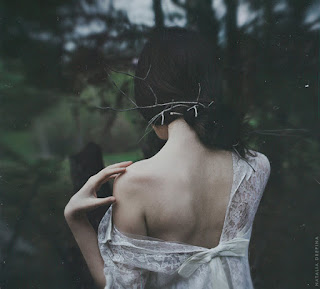Natalia Drepina is a Russian photographer who specialises in the dark arts, emotional portraits and female nude art. Her portraits are often deeply psychological and attempt to reflect the soul of the characters in the photographs and tell their story. Drapina's work uses mould, dried flowers and mud as a source of inspiration and creates a visual experience where 'natural, surreal and dream coexist in an amazing manner.'
I have chosen to look at Natalia Drepina's work as she contextualises the elements within each of her portraits. Each of Drepina's photographs are composed in a symmetrical way to draw the viewer in to the story of the model. I shall take inspiration from Drepina's work in how we as individual's interact with the 'elements' and how we can use them to tell a story.
The focus of this photograph is effective as the flame is in clear focus whereas the rest of the image has a softer focus therefore making the flame the main point of the image. This has also emphasised by the composition of the photo as it draws the viewers attention into the flame and makes the audience disregard the girl in the photograph.

This photograph creates a sense of mystery as it breaks the rule of thirds and therefore draws the viewer into the photograph and the story of the model. The use of the twigs in the hair is subtle use of the 'elements,' I hope to take inspiration from Drepina's work and to show the interactions with the 'elements' using a subtle approach.

Drepina has used contrast to emphasise the composure of the photograph, creating a gradient from light to dark. This is effective as it draws the eye to the details within the model's dress, the composure of the dress creates a sense of drowning because of the difference in visibility of the patterns of the dress.

The crop of this photograph is effective as the model's face has been removed, this creates a sense of mystery and interest within the viewer as they become intrigued in the story of the model. The choice of model is also effective as the paleness of her skin stands out against the dark background creates a greater depth of contrast.
My Response:
The composition in this photograph draws the viewers' attention to the flame as it sits on the left third, the position of the model's hands also draw attention to the flame as they frame the match.
The lighting is effective as it creates a shadow on the model's face, taking away their identity and creating a distance from the viewer. The lighting also creates a greater contrast with the flame. Both of these effects are in line with Drepina's work.
I like the composition of this photograph as the focus is on the leaves in the bottom third, however if I were to do this shoot again I would ask the model to wear a darker jumper as I think the grey stands out within the photo and therefore may distract the viewer.
The composition of this photograph is effective as the model's face has been cropped, this distances the audience from the model and draws their attention to the leaves. When taking this photograph, I used a 'cloudy' white balance, creating a warm tone - this enhances the colours of the leaves and the model's hair.
I used a fan to create wind in this photograph by showing the movement of the hair. I think the use of background is effective because its dark colours create contrast therefore making the model stand out against it.
I think the eeriness of this photograph is created by the desaturation and lack of contrast. I think the photo shows elements of Drepina's work by contextualising the element of water. However if I were to take this photo again I would change the crop as it looses its impact being so tightly cropped.
The composition of this photograph is effective as the material breaks the rule of thirds but the surrounding rocks maintain the rule and therefore the photo is pleasing to the eye. The rocks also create a frame around the water and material, which draw attention to the centre of the photograph. However I also think the positioning of the material is effective as only one end is visible therefore creating a sense of mystery and drawing the viewer into the story. I also think the lighting creates a powerful image through the use of shadows that surround the material.








No comments:
Post a Comment